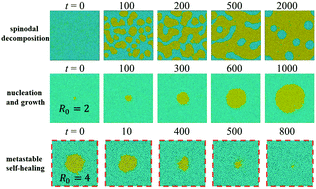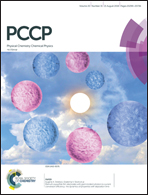Self-healing and dewetting dynamics of a polymer nanofilm on a smooth substrate: strategies for dewetting suppression
Abstract
The self-healing and dewetting dynamics of a polymer nanofilm on a smooth, partial wetting surface are explored by many-body dissipative particle dynamics. Three types of dewetting phenomena are identified, (i) spinodal decomposition, (ii) nucleation and growth, and (iii) metastable self-healing. The outcome depends on the surface wettability (θY), the polymer film thickness (h0), and the radius of the dry hole (R0). The phase diagram of the dewetting mechanism as a function of θY and h0 is obtained for a specified R0. As the surface wettability decreases (increasing θY), the critical film thickness associated with the nucleation/self-healing crossover (hc) grows so that the metastability of the film can be retained by the self-healing process. In addition to θY and R0, hc depends on the polymer length (N) as well. It is found that a longer polymer requires a thicker nanofilm to avoid dewetting by nucleation. Two strategies for dewetting suppression are proposed. The metastability of a film of polymers with a large molecular weight can be promoted either by the addition of short polymers or by employing compact polymers such as star polymers. In the latter approach, the increment of the arm number enhances the nanofilm stability.



 Please wait while we load your content...
Please wait while we load your content...